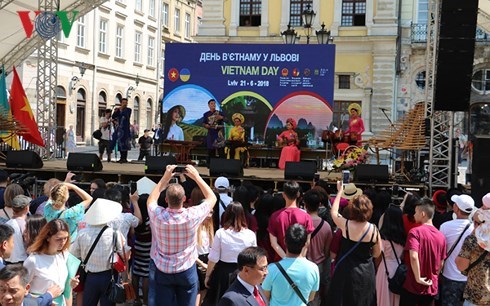
The "Vietnam Day” programme was recently held in Lviv city, the centre of culture and history in western Ukraine, as part of activities of the Vietnamese Cultural Year in Ukraine.

A photo of the "Vietnam Day" programme held in Lviv city of Ukraine (Photo: VOV).
The event was co-held by the Embassy of Vietnam in Ukraine and the Vietnamese Ministry of Culture, Sports and Tourism, the Vietnam-Ukraine Friendship Association and local authorities.
Organised in western Ukraine for the first time, the "Vietnam Day” saw the participation of Vietnamese people across the nation as well as in neighbouring countries such as Germany, Poland and Hungary.
The programme featured a series of activities, including fairs introducing Vietnamese goods and cuisine, along with seminars on tourism cooperation and a photo exhibition on Vietnam’s landscapes and people.
A highlight of the event was an art programme with Vietnam’s traditional instruments performed by artists of Vietnam and overseas Vietnamese (OVs) from Ukraine’s cities of Kiev, Odessa and Kharkov, attracting many people and tourists in Lviv city.
At the opening ceremony, Vietnamese Ambassador to Ukraine Nguyen Anh Tuan stressed that the event was designed to introduce images of Vietnam to Ukrainian friends in the western region and tourists in Lviv, thus deepening the Vietnam-Ukraine traditional friendship.
It also aimed to enhance mutual understanding of people and businesses of the two countries and foster the connection of Vietnam’s localities and agencies with Ukraine and Lviv city in particular, he added.
The event also offered chances for OVs in Ukraine and neighbouring countries to meet with each other and their Ukrainian friends.-
Source: VNA
With an increasingly vibrant and widespread emulation movement aimed at building cultured residential areas and cultured families, Yen Thuy District has been making steady progress toward improving both the material and spiritual well-being of its people, while fostering a civilized, prosperous, beautiful, and progressive community.
Once lacking recreational spaces and community facilities, Residential Group 2 in Quynh Lam Ward (Hoa Binh City) has recently received attention for the construction of a new, spacious, and fully equipped cultural house. The project followed the model of state support combined with public contributions in both labor and funding.
The "All people unite to build cultural life" movement, which has been effectively integrated with Kim Boi district’s socio-economic development goals, is fostering a lively spirit of emulation across local residential areas, hamlets, villages, public agencies, and enterprises. In addition, through the initiative, traditional cultural values are being preserved and promoted, while community solidarity and mutual support in poverty reduction and economic development are being strengthened.
A working delegation of the Hoa Binh provincial People’s Committee led by its Permanent Vice Chairman Nguyen Van Toan on June 11 inspected the progress of a project to build the Mo Muong Cultural Heritage Conservation Space linked to tourism services in Hop Phong commune, Cao Phong district.
Born and growing in the heroic land of Muong Dong, Dinh Thi Kieu Dung, a resident in Bo town of Kim Boi district, in her childhood was nurtured by the sweet lullabies of her grandmother and mother. These melodies deeply imprinted on her soul, becoming an inseparable part of her love for her ethnic group's culture. For over 20 years, this love for her hometown has driven Dung to research, collect, and pass down the cultural values of the Muong people to future generations.
In the final days of May, the Ethnic Art Troupe of Hoa Binh Province organized performances to serve the people in remote, mountainous, and particularly disadvantaged areas within the province. These were not just ordinary artistic shows, but they were the meaningful journeys aimed at spreading cultural values, enhancing the spiritual life of the people and contributing to the preservation of ethnic minority cultural identities.



